
That starry night sky? It's full of eclipses PhysOrg - April 3, 2024
The term eclipse is most often used to describe either a solar eclipse, when the Moon's shadow crosses the Earth's surface, or a lunar eclipse, when the Moon moves into the Earth's shadow. However, it can also refer to such events beyond the Earth-Moon system: for example, a planet moving into the shadow cast by one of its moons, a moon passing into the shadow cast by its host planet, or a moon passing into the shadow of another moon. A binary star system can also produce eclipses if the plane of the orbit of its constituent stars intersects the observer's position.

That starry night sky? It's full of eclipses PhysOrg - April 3, 2024
We also can see eclipses involving Mercury and Venus, the two planets in our solar system that orbit the sun more closely than Earth, as they pass between our telescopes and the sun (though only by using telescopes with protective filters to avoid eye damage). In these rare events, the planets are tiny dots crossing the sun's much larger disk. Astronomers can, in a sense, see eclipses among other systems of planets orbiting their parent stars. In this case, the eclipse is a tiny drop in starlight as a planet, from our point of view, crosses the face of its star. That crossing, called a transit, can register on sensitive light sensors attached to telescopes on Earth and those in space, such as NASA's Hubble Space Telescope, James Webb Space Telescope, or TESS (the Transiting Exoplanet Survey Satellite). It's how the bulk of the more than 5,500 confirmed exoplanets - planets around other stars - have been detected so far, although other methods also are used to detect exoplanets.

A lunar eclipse is an astronomical event that occurs when the Moon moves into the Earth's shadow, causing the Moon to be darkened. Such an alignment occurs during an eclipse season, approximately every six months, during the full moon phase, when the Moon's orbital plane is closest to the plane of the Earth's orbit.
This can occur only when the Sun, Earth, and Moon are exactly or very closely aligned (in syzygy) with Earth between the other two, which can happen only on the night of a full moon when the Moon is near either lunar node. The type and length of a lunar eclipse depend on the Moon's proximity to the lunar node.


When the Moon is totally eclipsed by the Earth (a "deep eclipse"), it takes on a reddish color that is caused by the planet when it completely blocks direct sunlight from reaching the Moon's surface, as only the light reflected from the lunar surface has been refracted by the Earth's atmosphere. This light appears reddish due to the Rayleigh scattering of blue light, the same reason sunrises and sunsets are more orange than during the day.
Unlike a solar eclipse, which can only be viewed from a relatively small area of the world, a lunar eclipse may be viewed from anywhere on the night side of Earth. A total lunar eclipse can last up to nearly two hours, while a total solar eclipse lasts only a few minutes at any given place, because the Moon's shadow is smaller.
Also, unlike solar eclipses, lunar eclipses are safe to view without any eye protection or special precautions. Continue reading

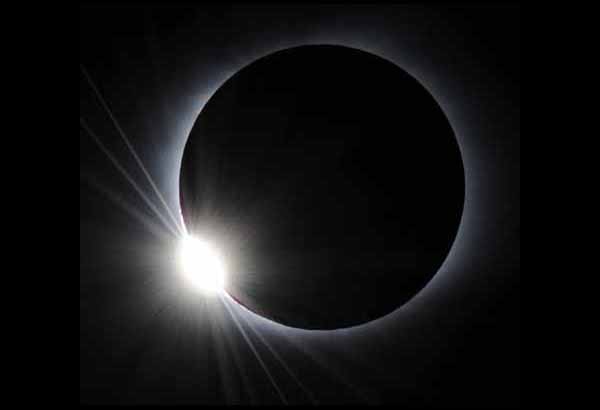
A solar eclipse occurs when the Moon passes in front of the Sun and obscures it totally or partially. This configuration can only exist at New Moon, when Sun, Moon and Earth are on a single line with the Moon in the middle.
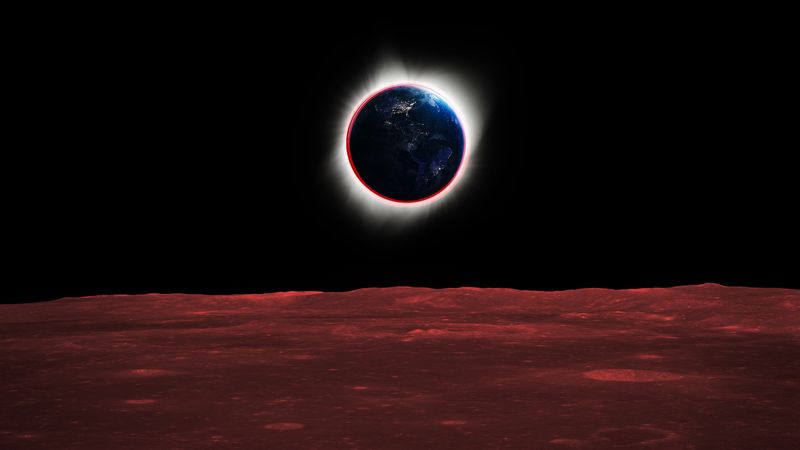
There are four types of solar eclipses:
A total solar eclipse occurs when the Moon completely obscures the Sun. This happens when the Moon is near perigee and its angular diameter as seen from Earth is identical to or slightly larger than that of the Sun. A total solar eclipse is the only opportunity to observe the Sun's corona without specialized equipment.
An annular (ring-formed) eclipse occurs when the Moon's center passes in front of Sun's center while the Moon is near apogee. The Moon's angular diameter is then smaller than that of the Sun so that a ring of the Sun can still be seen around the Moon. This is similar to a penumbral eclipse.
A hybrid eclipse occurs when the curvature of Earth's surface causes a single solar eclipse to be observed as annular from some locations but total from other locations. A total eclipse is seen from places on the Earth's surface that lie along the path of the eclipse and are physically closer to the Moon, and so intersect the Moon's umbra; other locations, further from the Moon, fall in the Moon's antumbra and the eclipse is annular.
The term "solar eclipse" is a misnomer: the phenomenon is actually an occultation. An "eclipse" occurs when one celestial object passes into the shadow cast by another (as with an eclipse of the Moon). An "occultation' occurs when one body passes in front of another. When at its new phase the Moon passes in front of, or occults, the Sun, as seen from Earth, the Moon also casts a small shadow on Earth. An "occultation" of the Sun is therefore also a partial "eclipse" of Earth.
Looking at the Sun is dangerous at any time when any part of the brilliant visible disk of the Sun (its photosphere) is visible; to do so can cause permanent eye damage. This is true at any time, including during solar eclipses; since an eclipse offers an unusually high temptation to look at the Sun, there is a high incidence of eye damage caused during solar eclipses. Viewing the Sun through any kind of optical aid, binoculars, a telescope, or even a camera's viewfinder- is extremely dangerous.

The Sun can be viewed using appropriate filtration to block the harmful part of the Sun's radiation. Note that sunglasses are of little use, since they don't block the harmful and invisible infra-red radiation which causes retinal damage; other improvised methods, such as using a reflection in water, or looking through a compact disk, are equally dangerous. Only properly designed and certified solar filters should ever be used for direct viewing of the Sun; and these must be in perfect condition, as even a small defect could cause damage.
The safest way to view the Sun is by indirect projection. This can be done by projecting an image of the sun onto a white piece of paper or card using a pair of binoculars (with one of the lenses covered), a telescope, or another piece of cardboard with a small hole in it (about 1 mm diameter), often called a pinhole camera.
The projected image of the sun can then be safely viewed; this technique can be used to observe sunspots, as well as eclipses. However, care must be taken to ensure that no-one looks through the projector (telescope, pinhole, etc.) directly, as this will cause severe eye damage; particular care should be taken if children are present.It is safe to directly observe the total phase of a total solar eclipse, when the Sun's photosphere is completely covered by the Moon; indeed, this is a very beautiful sight.
The Sun's faint corona will be visible, and even the chromosphere, solar prominences, and possibly even a solar flare may be visible. The danger here is of being caught out by the end of the total phase, and the return of the "exposed" Sun; because all parts of the Sun's disk are of similar intensity, even a tiny sliver of the Sun could cause permanent eye damage. For this reason, viewing the total phase of a solar eclipse through binoculars or a telescope should not be recommended.
Total and annular eclipses both occur when the Moon lines up with the Sun exactly, but since the Moon's orbit is not perfectly circular it is sometimes farther away from Earth and doesn't always cover the entire solar disc from an Earthly vantage point.
It is one of the most remarkable coincidences of nature that the Sun lies approximately 400 times as far away from Earth as does the Moon, and the Sun is also approximately 400 times as large in diameter as the Moon. As a result, as seen from Earth, the Sun and the Moon appear to be nearly the same apparent size. The Moon orbits Earth in an elliptical, or elongated orbit, however, and not in a circular orbit.
Thus during about 55-60% of its orbit the Moon is far enough from Earth ("apogee") that it is too small to cover the Sun's surface completely. During the remaining portion of its orbit, it is closer to Earth ("perigee") and large enough in apparent size to cover the Sun completely.
When a solar eclipse occurs near apogee, there is therefore a small ring or annulus of Sun that remains uncovered even at the moment of maximum eclipse. This produces an "annular" eclipse, during which the brilliant and blinding uncovered ring of the Sun makes the solar corona invisible. When a solar eclipse occurs near perigee, however, the Moon is close enough to Earth and large enough in the sky that it can cover the entire bright surface (the photosphere) of the Sun completely, and the observer sees a total eclipse, at which time the ghostly white solar corona appears.
A solar eclipse can only be seen in a band across Earth as the Moon's shadow moves across its surface, while a total or annular eclipse is actually total or ring-formed in only a small band within this band (the eclipse path), and partial elsewhere (total eclipse takes place where the umbra of the Moon's shadow falls, whereas a partial eclipse is visible where the penumbra falls). The full band is generally around 100 km in width. The eclipse path will be widest if the Moon happens to be at perigee, in which case the eclipse path alone can reach 270 km in width.

Total solar eclipses are rare events. Although they occur somewhere on Earth approximately every 18 months, it has been estimated that they recur at any given spot only every 300 to 400 years. And after waiting so long, the total solar eclipse only lasts for a few minutes, as the Moon's umbra moves eastward at over 1700 km/h.
Totality can never last more than 7 min 40 seconds, and is usually a good deal shorter. During each millennium there are typically fewer than 10 total solar eclipses exceeding 7 minutes. The last time this happened was June 30, 1973. Those alive today probably won't live to see it happen again, on June 25, 2150. The longest total solar eclipse during the 8,000-year period from 3000 BC to 5000 AD will occur on July 16, 2186, when totality will last 7 min 29 s. (eclipse predictions by Fred Espenak, NASA/GSFC.)
For astronomers, a total solar eclipse forms a rare opportunity to observe the corona (the outer layer of the Sun's atmosphere). Normally this is not visible because the photosphere is much brighter than the corona.
If you know the date and time of a solar eclipse, you can predict other eclipses using eclipse cycles. Two well-known eclipse cycles are the Saros cycle and the Inex cycle. The Saros cycle is probably the most well known, and one of the best, eclipse cycles. The Inex cycle is itself a poor cycle, but it is very convenient in the classification of eclipse cycles. After a Saros cycle finishes, a new Saros cycle begins 1 Inex later (hence its name: in-ex).
Near the beginning and end of total solar eclipse, the thin slice of the Sun visible appears broken up into beads of light. These lights are called Baily's Beads after the British astronomer Francis Baily who discovered them. They occur because the edge of the Moon is not smooth but jagged with mountain peaks.

When just one bead is visible, the effect is often likened to a diamond ring.


Photographers capture the exact moment a gargantuan storm blasts out of the sun during a total solar eclipse Live Science - May 4, 2023
The rare eclipse, which occurred April 20, is known as a hybrid because it consisted of two separate eclipses occurring at the same time. These included a total solar eclipse - a fleeting yet complete occultation of the sun - and an annular solar eclipse: A longer yet incomplete eclipse where a halo of plasma remains visible around the moon. Although the eclipses occurred at the same time, most observers could only see one or the other depending on their location. The total solar eclipse was only visible to people who were perfectly positioned in line with the moon and the sun. Most people would have seen the annular eclipse instead. It was the first hybrid eclipse in more than a decade.

Ancient civilizations used the movement of the heavens as celestial calendars. They created great stone monuments called astronomical observatories to this end. To the ancients, an eclipse often represented the Eye of God, All Seeing Eye!
Ancient observations of solar eclipses from many different cultures and civilizations date back to at least 2500 BC in the writings that have survived from ancient China and Babylon. To establish an accurate luni-solar calendar, people in ancient civilizations observed the moon regularly. Lunar eclipses were the first major celestial events that astrologers learned how to predict based on local historical observation records.
One of the first things civilizations must do to ensure a coherent society is to establish an accurate calendar to organize planting and harvesting of crops. Most early calendars were lunar calendars, because the monthly duration of the lunar cycle is 29.53 days, 12.37 months during a solar seasonal year. Every year, the lunar "synodic" calendar of 29.53 days slips by 0.38 of a month or 11.2 days relative to the seasonal "planting" year.
At the same time that ancient people kept track of how the lunar and solar calendars meshed with each other, they also uncovered some of the factors that lead to lunar and solar eclipses which also require specific timings of the solar and lunar positions across the sky and over the years. In many ways, the ability to predict eclipses was an outgrowth of the pre-existing need to keep track of lunar and solar calendar relationships.
Oldest Ever Record Of A Solar Eclipse Discovered Pretty Much In Front Of Our Faces - Central or Northern Asia IFL Science - September 3, 2024
At around 6,000 years old, it predates the previous contenders by quite a margin. We live in an age where things like the Earth orbits the sun and Kepler’s third law are well known, and yet the majesty of a solar eclipse is still something that can make even the most powerful man in the world stop and stare. How much more awe-inspiring must this cosmological phenomenon have appeared, then, to our ancestors many millennia ago?
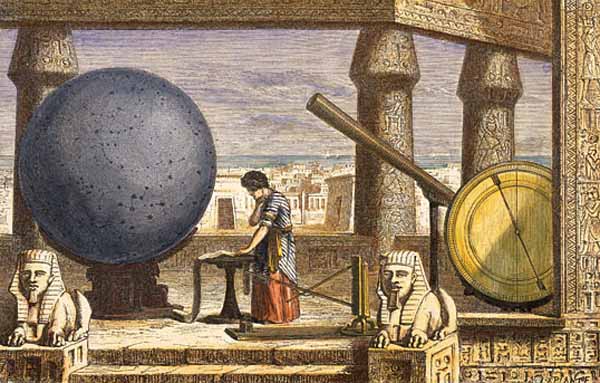
Ancient Egypt -- Nearly all we know about ancient Egyptian civilization's knowledge of astronomy comes to us from tomb paintings, various temple inscriptions, and a handful of papyrus documents such as the Rhind Papyrus. Unfortunately, the Great Library in Alexandria was burned during the time of Cleopatra and Julius Caesar. Later burnings in AD 390 and AD 640 destroyed an estimated 400,000 books on Egyptian secular literature, mathematics, medicine, and astronomy. All that survives is fragments that some scholars see as merely the faded ghosts of Egyptian intellectual legacy.
The oldest example of a sundial is Egyptian from about 1500 BC. The fabulous astrological ceiling of Senmut painted around 1460 BC, includes celestial objects such as Orion, Sirius, and the planets Mercury, Venus, Jupiter, and Saturn. The oldest known copies of an almanac date from 1220 BC at the time of Ramses the Great. In 1100 BC Amenhotep wrote "Catalog of the Universe" in which he identified the major known constellations.
Curiously, the catalog does not mention either Sirius or any of the planets previously known to the Egyptians. At least outwardly, there are no surviving inscriptions or documents to indicate that Egyptian knowledge of astronomy was more than tomb decoration, and not protected over the ages as a body of knowledge.
Numerous temple and pyramid alignments and several papyrus codices suggest a sophisticated knowledge of trigonometry and algebra; no similar astronomy documents survive, or records of astrological observations.
The Vienna papyrus which described lunar and solar eclipses and their portent was probably copied by a scribe in the late second century AD, and presents knowledge of astronomy that is regarded as Babylonian in nature.
A full discussion of the presumed knowledge of solar eclipses by the ancient Egyptians is beyond the scope of these brief comments. However, it is pertinent to note that Greek writers, without exception, gave priority to Egypt in astronomical knowledge. Still, there has not yet come to light an Egyptian document specifically mentioning solar eclipses. However, that the Egyptians possessed accurate knowledge of eclipses is evident from external sources.
Diodorus Siculus (200 A.D.), stated categorically that the ancient Egyptian astronomers possessed the ability to predict solar eclipses. Plutarch related that the ancient Egyptians explained solar eclipses by the passage of the Moon between the Sun and the earth in daylight hours. There is evidence, admittedly disputed by some writers, that an actual solar eclipse was reported in Egypt in the 9th century B.C. and again in 610 B.C.
The report of this latter eclipse has been attributed to Thales, though others, e.g., Herodotus, claim that Thales actually predicted an eclipse in 584 B.C. Thales, Greece's first "philosopher", was actually of Phoenician birth and spent seven years studying in Egypt. Greek commentators attribute Thale's mathematical and astronomical knowledge to this apprenticeship in Egypt.
The golden age of Greek science commences with the Ptolemaic dynasty (330 B.C.) in Egypt, the building of Alexandria, and the founding of the city's Library. The major Greek astronomers studied there. Moreover, several of the Alexandrian astronomers considered Greek were actually Egyptians who had adopted or been given Greek names. One such person was Ptolemy (150 A.D.), author of the Almagest, the most important astronomical text until the Middle Ages, whose knowledge of solar eclipses is well-documented.
Clement of Alexandria (2nd century A.D.), author of Stromateis described 49 books of Thoth preserved by the priests of ancient Egypt, at least four of them treating astronomical subjects. One book dealt with the "constitution of the Sun and Moon" and another "the conjunctions and variations of the light of the Sun and Moon." That the ancient astronomer-priests of Egypt could and did predict eclipses was considered axiomatic. Information detailing Egyptian priesthood repeatedly confirm the remarkable ability of that priesthood to predict solar eclipses.
Horus the Hawk is the Sun in totality.
The Sun god Atum is the eclipsed Sun passing the second contact of a total eclipse.
Ra is the eclipsed Sun shining past the third contact as the Diamond Ring (Sacred Geometry)
The Scarab Khepri was a representation of the dark New Moon.
The Great Sphinx was the Egyptian Lord of Solar Eclipses.
Hathor was the Egyptian Goddess of Solar Eclipses.


Pyramid Texts: "The eclipse represents the breaking of the Egg and Splitting the Iron." The iron is the rod, the magnetic poles, north/south, duality of experience created by electromagnetic energy, the aura, needed to create a physical reality and the illusion of linear time. The Two 'Diamond Ring Effects' crowned the eclipsed shadow on the head of Re.
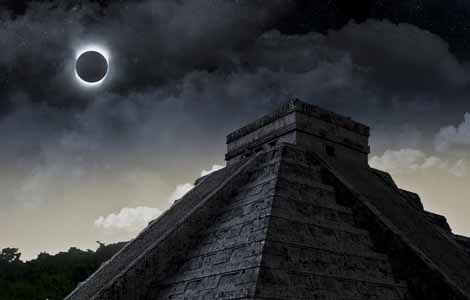
The Mayan knowledge of astronomy and mathematics defies history for their time line leading one to conclude, that like all ancient civilizations, they had help from Ancient Astronauts (Aliens). Mayan observers were working on calendars and recording celestial observations. The Dresden Codex records several tables thought to be lunar eclipse tables.
As in previous civilizations in other parts of the world, the Mayas used records of historical lunar eclipses to calculate how often they occurred over a 405-month period. There is no mention of recorded total solar eclipses, or discussions in the Codex for how to predict these events. After the Spanish Conquistadores, came the missionaries in the 1600s who intentionally destroyed nearly all native written record. Little survives to tell us whether the Mayas, Incas, or Aztecs achieved a deeper understanding of solar eclipses and their forecasting.
Maya astronomers were so accurate that one has to imagine how their calendars could be so accurate into the future. They were well aware that small cycles lead inevitably to bigger ones.
Their codex seems to have been a mechanism for predicting not when the first crescent moons of the future could be sighted, but which full moons would be eclipsed and which new moons would eclipse the sun. It must have taken all of a century or more, which means several generations of perceptive astronomical observing, for specialists in skywatching to work through to a conclusion that their Chinese and Babylonian counterparts also had arrived at, i.e. that once a lunar or solar eclipse occurs, it is not possible to have another (of the same kind) until six, or more rarely, five months pass.
Of the long-range Moon cycle in the Dresden Codex this much is certain: First, it was used to gain control of astronomical time; and second, it was a time cycle derived from the observation of eclipsed and non-eclipsed moons of the past, which could be used as data to generate a model for anticipating the occurrence of future lunar eclipses - powerful knowledge in the hands of the rulership.
Is the Dresden Codex a record of eclipses in part intended to warn of possible future eclipses? And, if so, what kind of eclipses? There seems little doubt that the Mayas sought to predict eclipses because of the disaster that they believed threatened them on such occasions. The omens in the table look ominous enough, at least to us. Of course, predictions must be based upon recorded observations of actual eclipses that occurred in Yucatan when the Mayan priests did their work. Though scholars are not in agreement over which particular set of eclipses (lunar or solar) was being observed, there is enough evidence to support the hypothesis that the Dresden Eclipse Table was devised for warning of the possible occurrence of such phenomena.
Both lunar and solar observational eclipse data can be utilized to construct a semblance of the Dresden Table. The hypothesis that lunar data were actually used seems much simpler. In the course of the thirty-three years spanned by the table, the number of such eclipses observable in Yucatan would have been significant enough to enable a single priest to draw up the table. If we assume that solar eclipses alone were used, and this certainly cannot be ruled out, we must extrapolate the base of observations backward many centuries in order to derive the relevant intervals.
The eight pages of the Moon table of the Dresden Codex are a chain of numbers across the bottom line of each page translates into a time packet of lunar synodic intervals. There are clumpings of six lunar synodic months (178 days) followed by one set of five (148 days). Each bunch of five moons is followed by a picture. A close look at all of the pictures together gives very strong clues about what the Mayas would do, parcel out a chain of 405 full moons over more than three decades. The answer is that Mayan astronomers were attempting, apparently quite successfully, to predict eclipses.

To the ancient Chinese, solar eclipses meant that dragons were devouring the sun.
The Chinese produced the first planetarium, which was actually made by an emperor. The planetarium was a big enclosed place with stars and constellations on the inside. The person using the planetarium would sit in a chair that was hanging from the top of the enclosed dome.
A solar eclipse of 16 June 763 BC mentioned in an Assyrian text is important for the Chronology of the Ancient Orient.
By 2300 BC, ancient Chinese astrologers, already had sophisticated observatory buildings, and as early as 2650 BC, Li Shu was writing about astronomy. Observing total solar eclipses was a major element of forecasting the future health and successes of the Emperor, and astrologers were left with the onerous task of trying to anticipate when these events might occur. Failure to get the prediction right, in at least one recorded case in 2300 BC resulted in the beheading of two astrologers. Because the pattern of total solar eclipses is erratic in any specific geographic location, many astrologers no doubt lost their heads. By about 20 BC, surviving documents show that Chinese astrologers understood what caused eclipses, and by 8 BC some predictions of total solar eclipse were made using the 135-month recurrence period. By AD 206 Chinese astrologers could predict solar eclipses by analyzing the Moon's motion.
Ancient Chinese astronomy was primarily a government activity. It was the astronomer's role to keep track of the solar, lunar, and planetary motions as well as divine what astronomical phenomena may mean for the ruling emperor. Solar eclipses, infrequent and dramatic, were important enough to be recorded in chronicles and on "oracle" bones.
Below are a few translated eclipse records found in the documents of ancient China from various dynasties. In general, the translations give the Roman calendar dating of the event, the Chinese dating, and the observation. Following in parentheses is the record in which the observation is noted. More translated records can be found in the references given below. Unless otherwise noted, the translations below can be found in the book Historical Eclipses and Earth's Rotation by F. Richard Stephenson.
"Oracle" bones are pieces of animal bones and tortoise shells inscribed with astronomical observations, that were probably used for divinations. Oracle bones hail from the Shang dynasty (c. 1600, 1050 BC) and make many references to solar eclipses. The eclipse records are often incomplete, however, and the dating of the bones is not reliable.
Eclipse observations from the Chou dynasty and Warring States period (c. 1050-221 BC), and onward, have been reliably dated, and it appears that some astronomers recognized eclipses as naturally occurring phenomena. From the Chou dynasty, 36 solar eclipse observations are recorded in the Ch'un-ch'iu beginning around 720 BC. The Piao and the Shih-chi documents refer to nine solar eclipses from the Warring States period.
Records of solar eclipses from the Han dynasty (206 BC, 220 AD) are found primarily in two official histories: the Han-shu and the Hou-han-shu. There are no records of eclipses from the Ch-in dynasty which came just prior to the Han dynasty (221 BC, 206 BC).
During the Ming dynasty (1368-1644 AD), total solar eclipse observations are found in the histories of Ming provinces after 1500 AD. Prior to 1500 AD, eclipse records can be found in the Imperial Annals. These observations, however, are not of total solar eclipses. Aug 20, 1514 AD: "At the hour of wu suddenly the Sun was eclipsed; it was total. Stars were seen and it was dark. Objects could not be discerned at arm's length. The domestic animals were alarmed and people were terrified. After one (double-)hour it became light." (local history of Tung-hsiang county, Chiang-his province)
Accurate eclipse timings can be used to determine the rate of the Earth's rotation. According to Steele and Stephenson, solar eclipse timings can be found from the periods between 600 and 800 AD, 1000 and 1300 AD, and a brief period during the Ming dynasty. These solar eclipse timings are accurate to about 0.4 hours.
Hindu astronomy is largely wrapped up in the Vedic religious treatises, but one individual, Aryabhata of Kusumapura, born in AD 476 is noteworthy. He is the first known astronomer on that continent to have used a continuous system of counting solar days. His book, The Aryabhatiya, published in 498 AD described numerical and geometric rules for eclipse calculations.
Indian astronomy at that time was taking much of its lead from cyclic Hindu cosmology in which nature operated in cycles, setting the stage for searching for numerical patterns in the expected time frames for eclipses.
In Hindu mythology, an eclipse is caused when a dragon-demon swallows the sun, while another myth is that sun rays during an eclipse can harm unborn children.
Babylonian clay tablets that have survived since dawn of civilization in the Mesopotamian region record the earliest total solar eclipse seen in Ugarit on May 3, 1375 BC.
A double (solar and lunar) eclipse took place 23 years after the ascension of king Shulgi of Babylon. This has been identified with eclipses that occurred on 9 May (solar eclipse) and 24 May (lunar eclipse), 2138 BC. This identification is however much less commonly accepted than the eclipse of 763 BC.
Like the Chinese, Babylonian astrologers kept careful records about celestial happenings including the motions of Mercury, Venus, the Sun, and the Moon on tablets dating from 1700 to 1681 BC. Later records identified a total solar eclipse on July 31, 1063 BC, that "turned day into night," and the famous eclipse of June 15, 763 BC, recorded by Assyrian observers in Nineveh. Babylonian astronomers are credited with having discovered the 223-month period for lunar eclipses.
At this time, the same lunar phase would be recorded at the same time of the solar calendar year. This period also gives a rough guide to when a lunar eclipse will recur at the same geographic location. Ptolemy (ca 150 AD) represents the epitome of knowledge of Grecian astronomy.
Records such as the Almagest show he had a sophisticated scheme for predicting both lunar and solar eclipses. Ptolemy knew, for example, the details of the orbit of the Moon including its nodal points. He also knew that the Sun must be within 20 degrees 41' of the node point, and that up to two solar eclipses could occur within seven months in the same part of the world.
Lunar eclipses were especially easy to calculate because of the vast area covered by Earth's shadow on the Moon. Solar eclipses however required much greater knowledge. The shadow of the Moon on Earth is less than 100 kilometers wide, and its track across the daytime hemisphere is the result of many complex factors that cannot be anticipated without a nearly complete understanding of the lunar orbit and speed.
Islamic astronomy became the western world's powerhouse of scientific research during the 9th and 10th centuries AD, while the Dark Ages engulfed much of the rest of the western world. The works by Ptolemy, Plato, and Aristotle were translated, amplified upon and spread throughout the Muslim world.
Al-Khwarazmi developed the first tables, trigonometric functions (ca 825 AD) which remained the standard reference well into the modern era. Al-Khwarazmi was known to the west as "Algorizm" and this is, in fact, the origin of the term 'algorithm'. Al-Khwarazmi's calculations were good to five places, allowing for unprecedented precision in astronomy and other sciences.
At Antioch, Muhammad al-Batani (ca 850 AD) began with Ptolemy's works and recalculated the precession of the equinoxes, and produced new, more precise astronomical tables. Following a steady series of advances in Islamic trigonometry, observations by Ibn Yunus of lunar and solar eclipses were recorded in Cairo ca 1000 AD. Ibn Yunus is regarded as one of the greatest observational astronomers of his time.
The pace of Islamic science and scholarship eventually slowed down in the 11th and 12th centuries. Many great books and great ideas of the Islamic Age lay fallow for hundreds of years until they were finally translated into Latin and fueled the European revolution in thinking and the birth of science as we know it today.

Surprising facts and beliefs about eclipses from the medieval and Renaissance eras PhysOrg - April 2, 2024
Eclipses were once associated with the deaths of kings - predictions played a key role in the birth of astronomy PhysOrg - April 8, 2024
Surprising facts and beliefs about eclipses from the medieval and Renaissance eras - they were omens, predictors of the future, and windows into the workings of the universe PhysOrg - April 8, 2024
During a solar eclipse, some Indigenous groups believe it's not just your eyes that need protecting
Medieval Europeans saw alignments of planets, like conjunctions of Jupiter and Saturn, as signs of things to come - from famines, earthquakes, and floods, to the birth of Christ, and even the ultimate collapse of empires. They believed that eclipses, especially solar eclipses, could amplify and strengthen the effects of these planetary conjunctions.
Greek astronomy reflects that Herodotus wrote Thales of Milete predicted an eclipse which occurred during a war between the Medians and the Lydians. Soldiers on both sides put down their weapons and declared peace as a result of the eclipse. Exactly which eclipse was involved has remained uncertain, although the issue has been studied by hundreds of ancient and modern authorities. One likely candidate took place on May 28, 585 BC, probably near the Halys river in the middle of modern Turkey.
An annular eclipse of the Sun occurred at Sardis on February 17, 478 BC, while Xerxes was departing for his expedition against Greece, as Herodotus, VII, 37 recorded ([Hind and Chambers, 1889: 323] considered this absolute date more than a century ago). Herodotus (book IX, 10, book VIII, 131, and book IX, 1) reports that another solar eclipse was observed in Sparta during the next year, on August 1, 477 BC. The sky suddenly darkened in the middle of the sky, well after the battles of Thermopylae and Salamis, after the departure of Mardonius to Thessaly at the beginning of the spring of (477 BC) and his second attack on Athens, after the return of Cleombrotus to Sparta.
By 450 BC, the Greek civilization was in its ascendancy. The historian Herodotus (ca 460 BC) mentions that Thales was able to predict the year when a total solar eclipse would occur. Details of how this prediction was made do not survive.
The eclipse occurred in either 610 BC or 585 BC. Apparently the method used worked only once because what is known of Greek scientific history does not suggest that the method was ever reliably used again. Thales is said to have visited Egypt, and from the empirical rules in use there for land surveying, brought back to Greece the ideas of deductive geometry later codified by Euclid. Before 450 BC, Meton realized that a single period of 235 lunar months (19 years) would cause the popular lunar calendar to return to synchrony with the solar, seasonal calendar.
Greek Mythology -- In the Odyssey, XIV, 151, Homer states that Odysseus will return to his home, and take vengeance on the suitors of Penelope, at the failing of the old moon and the coming of the new. Later in the Odyssey (XX, 356-357 and 390), Homer adds that the Sun vanished out of heaven and an evil gloom covered all things about the hour of the midday meal, during the celebration of the new moon. A total eclipse of the Sun was visible from the Greek island of Ithaca on April 16, 1178 BC. This would be six years after the end of the Trojan War, as traditionally dated (1184 BC), though within the Odyssey narrative it's supposed to be ten years after it.
'Zeus made night from mid-day': Terror and wonder in ancient accounts of solar eclipses Live Science - April 9, 2024
The foundation of Rome took place 437 years after the capture of Troy (1182 BC), according to Velleius Paterculus (VIII, 5). It took place shortly before an eclipse of the Sun that was observed at Rome on June 25, 745 BC and had a magnitude of 50.3%. Its beginning occurred at 16:38, its middle at 17:28, and its end at 18:16. Varro may have used the consular list with its mistakes, calling the year of the first consuls "245 ab urbe condita" (a.u.c.). A new study claims that the Varronian date has been superseded. Its correctness has not been proved scientifically but it is used worldwide.
According to Lucius Tarrutius of Firmum, Romulus was conceived in the womb on the 23rd day of the Egyptian month Choiac, at the time of a total eclipse of the Sun. This eclipse occurred on June 15, 763 BC, with a magnitude of 62.5% at Rome. Its beginning took place at 6:49, its middle at 7:47 and its end at 8:51. He was born on the 21st day of the month of Thoth.
The first day of Thoth fell on 2 March in that year. That implies that Rhea Silvia's pregnancy lasted for 281 days. Rome was founded on the ninth day of the month Pharmuthi, which was April 21, as universally agreed. The Romans add that, about the time Romulus started to build the city, an eclipse of the Sun was observed by Antimachus, the Teian poet, on the 30th day of the lunar month.
This eclipse had a magnitude of 54.6% at Teos, Asia Minor. It started at 17:49 and was still eclipsed at sunset, at 19:20. Romulus vanished in the 54th year of his life, on the Nones of Quintilis (July), on a day when the Sun was darkened. The day turned into night, which sudden darkness was believed to be an eclipse of the Sun. It occurred on July 17, 709 BC, with a magnitude of 93.7%, beginning at 5:04 and ending at 6:57. This eclipse data haa been calculated by Prof. Aurel Ponori-Thewrewk, retired director of the Planetarium of Budapest.
Plutarch placed it in the 37th year from the foundation of Rome, on the fifth of our month July, then called Quintilis, on "Caprotine Nones". Livy (I, 21) also states that Romulus ruled for 37 years. He was slain by the Senate or disappeared in the 38th year of his reign. Most of these have been recorded by Plutarch (Lives of Romulus, Numa Pompilius and Camillus), Florus (Book I, I), Cicero (The Republic VI, 22: Scipio's Dream), Dio (Dion) Cassius and Dionysius of Halicarnassus (L. 2). Dio in his Roman History (Book I) confirms these data by telling that Romulus was in his 18th year of age when he founded Rome. Therefore, three eclipse records prove that Romulus reigned from 746 BC to 709 BC.
Lunar and Solar eclipses have always been harbingers of change and evolution - both negative and positive - dating to ancient times and civilizations when an eclipse evoked fear of the unknown. We have learned to see beyond myth and dark magic that controls through illusion, and have moved into scientific understanding - though many still hold onto old beliefs linked to fear.
Eclipses not only have gravitational affect on our bodies and planet Earth, but also affect the collective unconscious, the grids, and hold astrological significance in our natal charts, as well as the charts of nations and businesses.
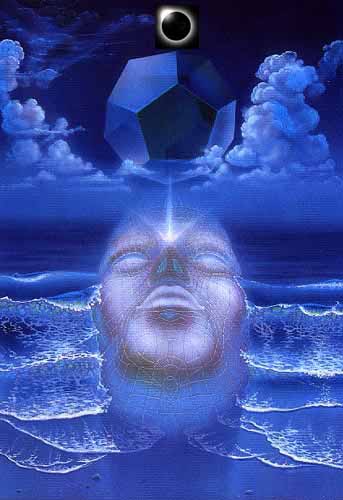
Sacred Geometry
Eclipse of consciousness in the alchemy of time
Enhances dreams and other out of bodies experiences.

Diamond shape symbolizes the star tetrahedron of sacred geometry,
mathematical patterns that create the grids, or matrixes, of our reality.
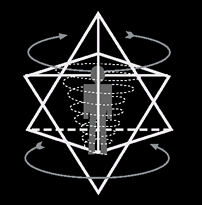
Star Tetrahedron - Star of David

Emerald Tablets of Thoth
As is above, So is below
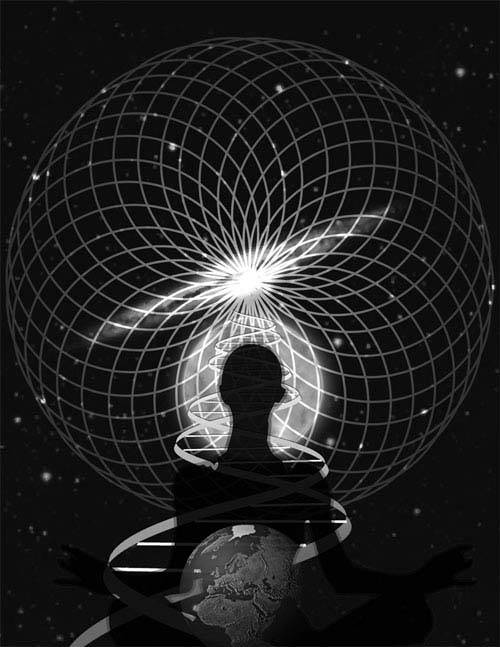
Simulation Theory

Kubrick's masterpiece film, 2001: A Space Odyssey refers to the heart of the Isis Osiris mythology. The monolith represents the male, the generative force - the dome (rising sun, egg), the female. The result is a new dawn (beginning). This parallels Egyptian mythology of the synthesis of Isis and Osiris to create Horus the Star Child.
Ellie's Blog: April 8, 2024 Solar Eclipse Text, Pics, Video

Ellie's Blog - August 21, 2017 Great America Solar Eclipse